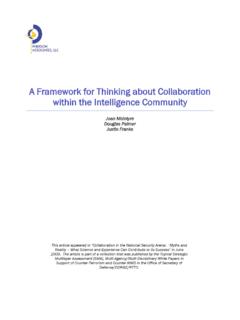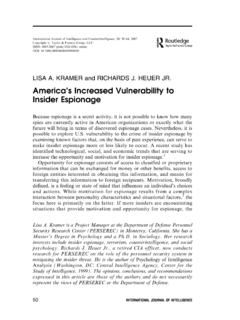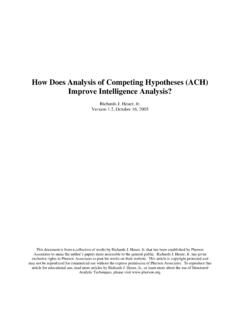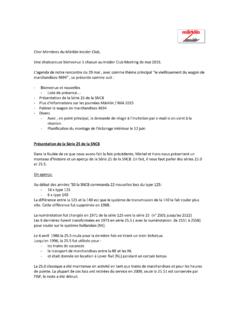Transcription of The Tradecraft of Warning: Overcoming Cognitive …
1 MICROSOFT The Tradecraft of Warning: Overcoming Cognitive barriers Randolph H. Pherson, Pherson Associates kreynolds [Pick the date] [Type the abstract of the document here. The abstract is typically a short summary of the contents of the document. Type the abstract of the document here. The abstract is typically a short summary of the contents of the document.] Warning analysts can reduce the chances of main-line analysts and policymakers being surprised by future events if they employ structured analytic techniques. This paper describes 12 tools some recently developed that warning analysts can employ to help them challenge assumptions, generate multiple hypotheses, discover unknown unknowns, and track alternative futures. Three techniques are particularly useful in helping analysts anticipate low probability events and avoid surprise: High Impact/Low Probability Analysis, What If? Analysis, and the Pre-Mortem Assessment.
2 Use of these techniques will ensure greater rigor in the analysis and reduce the chances of surprise. This paper was prepared for the Seminar on the Tradecraft of Warning: New Approaches and New Thinking, hosted by the ODNI s National Intelligence Council and the State Department s Bureau of Intelligence and Research on February 20, 2009. Copyright 2009 Pherson Associates, LLC. All Rights Reserved. 1 Mindsets: An Unavoidable Problem Postmortems of virtually every major intelligence failure over the past two decades have identified ingrained analytic mindsets as a key contributing cause. Mindsets, as bad as they may sound, are neither good nor bad, they are simply Extensive research in the field of Cognitive psychology has demonstrated that analytic mindsets are easy to form and extraordinarily difficult to overcome.
3 If the analyst is lucky and has happened on the correct mental mindset or, better yet, has tested his or her mindset and found it sound, the analysis will be accurate. It is far more often the case that first impressions, partial information, and sometimes faulty assumptions underpin analytic mindsets. This weak foundation then gradually gains credence as analysts encounter more data that reinforces their mindset. In some cases, analysts will actively mold new data to make it consistent with their emerging conceptual framework often a key reason that the warning klaxon is not sounded. When new data is consistently interpreted as business as usual and key assumptions are not challenged, the result, at best, is poor analysis; at worst, it becomes the explanation for why we have stumbled into another major intelligence failure. Time pressures increase the likelihood that an analyst will fall back on an initial hypothesis and not realize that he or she is headed down the wrong path until it is too late.
4 Usually the more important or politically significant an issue becomes, the greater the pressure to generate a finished product. In such an environment, it is the rare supervisor who argues that one must take the extra day, or even hour, to challenge key assumptions and review the quality of the data to ensure that we got it right. Often it falls to the warning analyst to provide the necessary counterweight to the chronic pressures to fit new events into existing frameworks and to make analytic judgments quickly. It is his or her job to help analysts recognize their Cognitive pitfalls and provide timely warning of unanticipated events. Strategies and Techniques for Overcoming Mindsets Past experience shows that it is exceedingly difficult to avoid premature closure and groupthink unless the analyst employs a specific tool or technique. Simply sensitizing analysts to the variety of analytic traps they are most likely to encounter rarely prevents them from falling into those traps.
5 Warning analysts can reduce the chances of main-line analysts and policymakers being surprised by future events if they employ structured analytic techniques. Copyright 2009 Pherson Associates, LLC. All Rights Reserved. 2 The techniques they employ should help analysts: Challenge key assumptions. Generate multiple hypotheses. Discover unknown unknowns. Track alternative future trajectories. Anticipate the unanticipated. Challenging Key Assumptions Two techniques have proven particularly effective in helping analysts identify and challenge the very foundations of their analysis: the Key Assumptions Check and Quadrant Crunching. Key Assumptions Checksii have been incorporated into National Intelligence Estimates for decades, but only in recent years has the technique gained wider acceptance across the Intelligence Community. All that the technique requires is that the analyst or the analytic team write down the key assumptions that underlie the analysis.
6 The process of literally writing down one s Key Assumptions (or listing them on a whiteboard) forces analysts to think critically about what they assume to be true. Most assumptions will stand up to challenge but, invariably, a few start to fall apart. Those assumptions often become Key Uncertainties rather than Key Assumptions. The author s experience in conducting Key Assumptions Check exercises over the past decade suggests that usually one in four key assumptions, initially presumed to be true, turns out on closer examination to be unfounded. A sound understanding of the assumptions underlying an analytic judgment sets the limits for the confidence the analyst ought to have in that judgment. The probability that the judgment is accurate cannot be greater than the probability of the accuracy of the weakest assumption. Another advantage of this technique is that the process forces the analyst to consider under what circumstances an assumption might not hold up, thereby sensitizing him or her to data that might otherwise have been ignored.
7 Warning analysts have found Quadrant Crunching, described by some as a Key Assumptions Check on steroids, an efficient and effective way to generate a broad set of alternatives when faced with little data and high degrees of uncertainty. This group process for identifying and examining all possible combinations of selected key variables helps analysts systematically challenge assumptions, explore the implications of contrary assumptions, and discover unknown unknowns. By generating multiple potential outcomes for any situation, it greatly reduces the chance that events could play out in previously unimagined ways. The Quadrant Crunching technique is particularly beneficial to military analysts because it helps analysts think through how an attack would be launched, what the most likely targets would be, and what signposts or indicators would suggest that a specific attack is in the Copyright 2009 Pherson Associates, LLC.
8 All Rights Reserved. 3 early stages of implementation. As a result, analysts, policymakers, and military decisionmakers can set priorities and generate specific sets of field requirements in response to highly ambiguous threats. Generating Multiple Hypotheses A hypothesis is a potential explanation or conclusion that is to be tested by collecting and presenting evidence. It is a declarative statement that has not been established as true an educated guess based on observation to be supported or refuted by more observation or through experimentation. Gaining confidence in a hypothesis is not a function solely of accumulating evidence in its favor, but also in showing that situations that could establish its falsity do not, in fact, happen. Satisficing and confirmation bias, two common causes of analytic failure, stand in the way of a rigorous examination of the evidence.
9 Satisficing is the technical term for the tendency to accept the first answer that comes to mind that is good enough. Confirmation bias refers to viewing the evidence only from the perspective of whether or not it supports our preconceived answer. Analysts who look for evidence that proves they are right often do not see or try to discredit the evidence that suggests they may be wrong. Starting analysis by generating multiple hypotheses, or potential explanations, rather than a single hypothesis can help the warning analyst avoid both Cognitive pitfalls. The leading techniques for Overcoming satisficing and confirmation bias are Multiple Hypotheses Generation, Analysis of Competing Hypotheses (ACH), and a recent web-based variant called Collaborative-Analysis of Competing Hypotheses (C-ACH). Multiple Hypothesis Generation is a technique for developing multiple alternatives for explaining a particular issue, activity, or behavior.
10 Analysts should develop multiple hypotheses at the start of a project when there is a high level of uncertainty about the outcome; many factors are involved in the analysis; or there are strongly held, competing views amongst analysts or decisionmakers. Pherson Associates has developed a new technique called the Hypotheses Generator to help analysts create multiple explanations for the data at hand. While analysts can often brainstorm a useful set of hypotheses without such a tool, the Hypotheses Generator gives warning analysts a greater degree of confidence that a critical alternative or an outlier possibility is not overlooked. Analysis of Competing Hypotheses is a tool to aid judgment on issues requiring careful weighing of alternative explanations or estimates. ACH involves the identification of a complete set of alternative explanations or outcomes (presented as hypotheses), the systematic evaluation of each, and the selection of the one that best fits the evidence.








